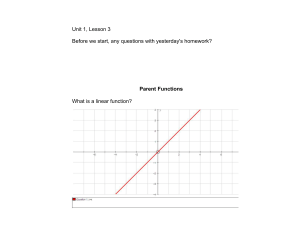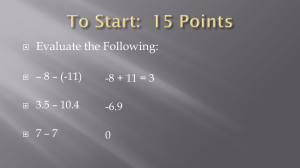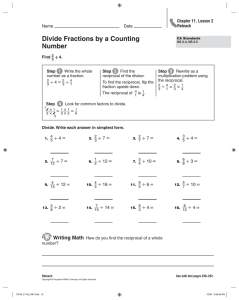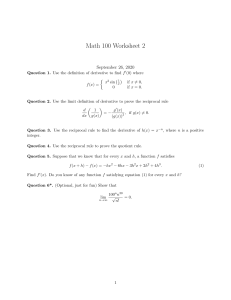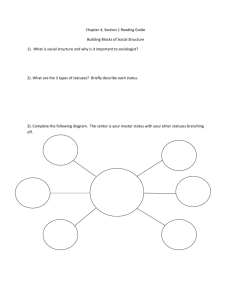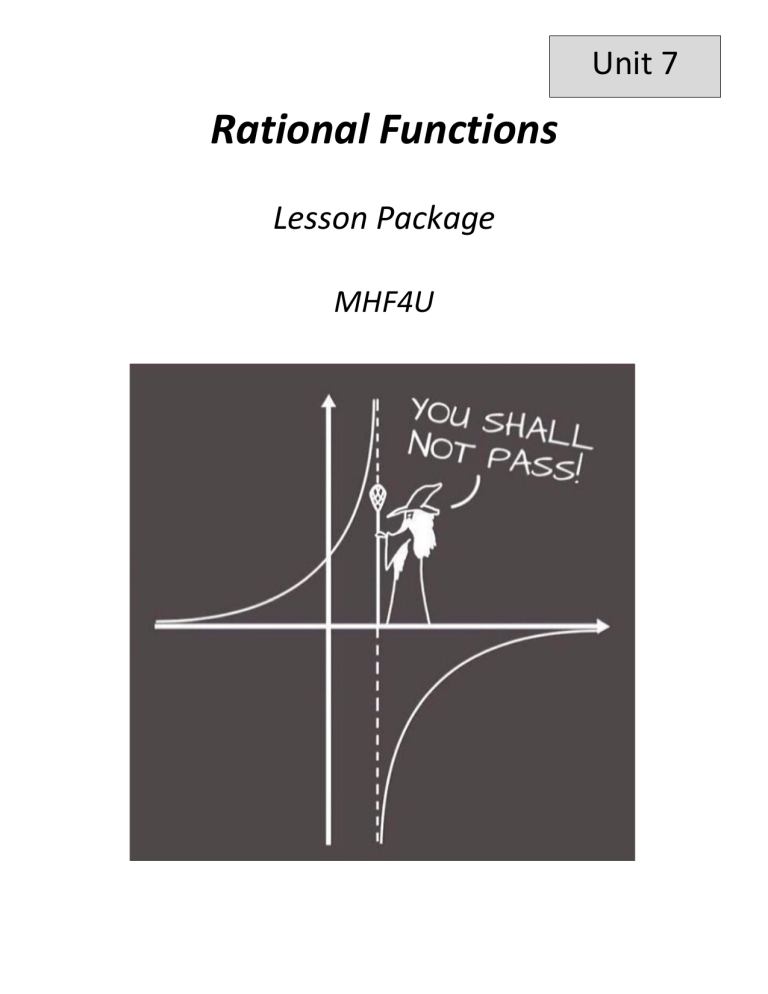
Unit 7
Rational Functions
Lesson Package
MHF4U
Unit 7 Outline
Unit Goal: By the end of this unit, you will be able to identify and describe the key features of the graphs of
rational functions, and represent rational functions graphically. Also, you will be able to determine functions
that result from the addition, subtraction, multiplication, and division of two functions and from the composition
of two functions.
Section
L1
L2
L3
Subject
Reciprocal of Linear
and Quadratic
Quotient of Linear
Functions
Combinations of
Functions
- connect algebraic and graphical representations of the reciprocals of
linear and quadratic functions
- connect algebraic and graphical representations of the quotient of
linear functions
- Identify key features of graphs of functions created by adding,
subtracting, multiplying, and dividing two functions
- determine algebraically the composition of two functions
L4
Composite Functions
L5
Rational Equations and
Inequalities
Assessments
Note Completion
Practice Worksheet Completion
Quiz – Graphing Functions
PreTest Review
Test – Reciprocal and
Combinations of Functions
Curriculum
Expectations
Learning Goals
- Be able to solve rational equations and inequalities
F/A/O
A
F/A
F
F/A
O
Ministry Code
A2.1, 2.2, 2.3, 3.4
C2.1, 2.2, 2.3
D2.1, 2.2, 2.3, 2.4, 2.5, 2.6, 4.2
P/O/C
P
P
P
P
P
C2.1, 2.3
C2.2, 2.3
D2.1, 2.2, 2.3
D2.4, 2.5, 2.6
C3.5, 3.6
C4.1, 4.2, 4.3
KTAC
K(21%), T(34%), A(10%),
C(34%)
L1 – 3.1/3.2 Reciprocal of Linear and Quadratic Functions
MHF4U
Jensen
Part 1: Analyze the Reciprocal of a Linear Function
Example 1:
a) Draw the horizontal and vertical asymptotes for the reciprocal function and state what they are
HA: 𝑦 = 0
VA: 𝑥 = −2
b) What graphical characteristic in the reciprocal function does the zero (𝑥-int) of the original function
correspond to?
The vertical asymptote of the reciprocal function passes through the 𝑥-intercept of the linear function.
c) When the original function is increasing, what is happening to the reciprocal function?
It is DECREASING
d) What are the 𝑦-coordinates of the points of intersection?
1 and -1. This is because the reciprocal of each of those does not change their value.
e) Label a point on the graph of both functions at 𝑥 = 2. What do you notice about the 𝑦 values of each point?
The 𝑦-value of the reciprocal function is the reciprocal of the 𝑦-value of the linear function
Part 2: Analyze the Reciprocal of a Quadratic Function
Example 2:
a) Draw the horizontal and vertical asymptotes for the reciprocal function and state what they are
VA: 𝑥 = 2 and 𝑥 = −2
HA: 𝑦 = 0
b) What graphical characteristic in the reciprocal function do the zeros (𝑥-int) of the original function
correspond to?
The vertical asymptotes of the reciprocal function pass through the 𝑥-intercepts of the quadratic.
c) When the original function is decreasing, what is happening to the reciprocal function?
It is INCREASING
d) What are the 𝑦-coordinates of the points of intersection?
1 and -1
f) Label the local min or max point on each function. What do you notice about them?
They have the same 𝑥-coordinate which is exactly half way between the vertical asymptotes.
The quadratic has a local min but the reciprocal has a local max.
Properties of Reciprocal Functions
•
•
•
•
•
•
•
•
All the 𝑦-coordinates of the reciprocal function are the reciprocals of the 𝑦-coordinates of the original
function
The graph of the reciprocal function has a vertical asymptote at the 𝑥-intercepts (zeros) of the original
o This is because it makes the denominator of the reciprocal = 0
𝑦 = 0 will always be a horizontal asymptote
The reciprocal function has the same positive/negative intervals as the original function
Intervals of increase on the original function are intervals of decrease on the reciprocal
Intervals of decrease on the original function are intervals of increase on the reciprocal
If 1 is in the range of the original function, this is where the functions will intersect
If the original function has a local min point, the reciprocal will have a local max at the same 𝑥-value
(and vice versa)
Part 3: Graphing Reciprocal Functions
Process:
•
•
•
•
Find key features of the function in the denominator and graph it using a table of values
Create a table of values for the reciprocal function by keeping the same 𝑥 values but using the
reciprocal of all 𝑦 values
Draw vertical asymptotes at any point that is a zero of the original linear/quadratic function
o Reciprocal of 0 is undefined
If the numerator is something other than 1, multiply the 𝑦-values by this stretch factor
Example 3: Graph each of the following reciprocal functions. Start by graphing the function in the
denominator.
!
a) 𝑦 = "#$!
𝒚 = 𝟐𝒙 − 𝟏
1
𝑥 − 𝑖𝑛𝑡: ( , 0)
2
Center x-int
𝒙
−2
−1
0
0.5
1
2
3
𝒚
−5
−3
−1
0
1
3
5
𝒚=
𝑉𝐴: 𝑥 =
𝟏
𝟐𝒙 − 𝟏
1
2
𝐻𝐴: 𝑦 = 0
𝒙
−2
−1
0
0.5
1
2
3
𝟏
𝒚
−0.2
−0.33
−1
𝑢𝑛𝑑𝑒𝑓𝑖𝑛𝑒𝑑
1
0.33
0.2
!
!
b) 𝑦 = # ! $"#$!% = (#$%)(#())
𝒚 = 𝒙𝟐 − 𝟐𝒙 − 𝟏𝟓
𝑥 " − 2𝑥 − 15
𝑥 − 𝑖𝑛𝑡: (5,0) and (−3,0)
Include 𝑥-int
Center the vertex
Include 𝑥-int
𝒙
−5
−3
−1
1
3
5
7
𝟏
𝒙𝟐 − 𝟐𝒙 − 𝟏𝟓
1
𝑥 ! − 2𝑥 − 15
= (𝑥 − 5)(𝑥 + 3)
𝑥 − 𝑣𝑒𝑟𝑡𝑒𝑥 = −
𝒚=
𝑏
−2
=−
=1
2𝑎
2(1)
𝒚
20
0
−12
−16
−12
0
20
=
1
(𝑥 − 5)(𝑥 + 3)
𝑉𝐴: 𝑥 = 5 and 𝑥 = −3
𝐻𝐴: 𝑦 = 0
𝒙
−5
−3
−1
1
3
5
7
𝟏
𝒚
0.05
𝑢𝑛𝑑𝑒𝑓𝑖𝑛𝑒𝑑
−0.08
−0.0625
−0.08
𝑢𝑛𝑑𝑒𝑓𝑖𝑛𝑒𝑑
0.05
!
c) 𝑦 = # ! (+
𝒚 = 𝒙𝟐 + 𝟒
𝒚=
𝒙 − 𝒊𝒏𝒕:
𝒙𝟐
𝟏
+𝟒
𝑉𝐴: 𝑛𝑜𝑛𝑒
"
𝑥 +4≠0
∴ 𝑛𝑜 𝑥 − 𝑖𝑛𝑡
𝐻𝐴: 𝑦 = 0
𝒙 − 𝒗𝒆𝒓𝒕:
𝑥=−
Center the vertex
𝑏
0
=−
=0
2𝑎
2(1)
𝒙
−3
−2
−1
0
1
2
3
𝒚
13
8
5
4
5
8
13
𝒙
−3
−2
−1
0
1
2
3
𝟏
𝒚
0.08
0.125
0.2
0.25
0.2
0.125
0.08
"
!
d) 𝑦 = # ! $,#(- = 2 O(#$))!P
𝒚=
𝟐
𝒚 = 𝒙 − 𝟔𝒙 + 𝟗
𝑥 " − 6𝑥 + 9
2
𝑥 ! − 6𝑥 + 9
= (𝑥 − 3)"
Center the vertex
= 26
1
7
(𝑥 − 3)!
𝑥 − 𝑖𝑛𝑡: (3,0)
𝑉𝐴: 𝑥 = 3
𝑥 − 𝑣𝑒𝑟𝑡𝑒𝑥 = 3
𝐻𝐴: 𝑦 = 0
𝒙
0
1
2
3
4
5
6
𝟐
𝒙𝟐 − 𝟔𝒙 + 𝟗
𝒚
9
4
1
0
1
4
9
𝒙
0
1
2
3
4
5
6
𝟐
𝒚
0.22
0.5
2
𝑢𝑛𝑑𝑒𝑓𝑖𝑛𝑒𝑑
2
0.5
0.22
L2 – 3.3 Quotient of Linear Functions
MHF4U
Jensen
Part 1: Key Features of the Quotient of Linear Functions
Features of 𝒇(𝒙) =
𝒂𝒙#𝒃
𝒄𝒙#𝒅
•
If an 𝑥 value is a zero of the denominator ONLY, this results in a vertical asymptote
'(
o Equation of vertical asymptote is 𝑥 =
•
If an 𝑥 value is a zero of the numerator AND denominator, this results in a hole in the graph NOT a
vertical asymptote
There is a horizontal asymptote at the ratio of the leading coefficients
*
o Equation of horizontal asymptote is 𝑦 = )
Forms a Hyperbola: the two branches of the graph of the function are equidistant from the point of
intersection of the vertical and horizontal asymptotes
o Once you know the shape of one branch, you can translate the points to graph the other branch
You can find the 𝑥-intercept by setting 𝑦 = 0 and solving for 𝑥
•
•
•
)
'+
•
o This results in ) * , 0+
You can find the 𝑦-intercept by setting 𝑥 = 0 and solving for 𝑦
+
o This results in )0, ( +
Part 2: Graphing a Quotient of Linear Functions
Example 1: Graph each of the following functions
,'-
a) 𝑓(𝑥) = ,#.
b) 𝑔(𝑥) =
.,','/
L3 – 8.1/8.2 Sum/Difference and Product/Quotient of Functions
MHF4U
Jensen
Part 1: Sum and Difference of Functions
When two functions 𝑓(𝑥) and 𝑔(𝑥) are combined to form the function (𝑓 + 𝑔)(𝑥) or (𝑓 − 𝑔)(𝑥), the new
function is called the sum or difference of 𝑓 and 𝑔.
The graph of 𝑓 + 𝑔 or 𝑓 − 𝑔 can be obtained by adding or subtracting corresponding 𝑦-coordinates. This is
called the superposition principle.
(𝑓 + 𝑔)(𝑥) = 𝑓(𝑥) + 𝑔(𝑥)
(𝑓 − 𝑔)(𝑥) = 𝑓(𝑥) − 𝑔(𝑥)
Example 1: Given 𝑓(𝑥) = −𝑥 ! + 3 and 𝑔(𝑥) = −2𝑥 determine the graphs of (𝑓 + 𝑔)(𝑥) and (𝑓 − 𝑔)(𝑥).
Method 1: Graphically
𝒙
𝒇(𝒙)
𝒈(𝒙)
𝒇(𝒙) + 𝒈(𝒙)
𝒇(𝒙) − 𝒈(𝒙)
-3
-6
6
0
-12
-2
-1
4
3
-5
-1
2
2
4
0
0
3
0
3
3
1
2
-2
0
4
2
-1
-4
-5
3
3
-6
-6
-12
0
Method 2: Algebraically
(𝑓 + 𝑔)(𝑥) = 𝑓(𝑥) + 𝑔(𝑥)
(𝑓 + 𝑔)(𝑥) = (−𝑥 ! + 3) + (−2𝑥)
(𝑓 + 𝑔)(𝑥) = −𝑥 ! − 2𝑥 + 3
(𝑓 − 𝑔)(𝑥) = 𝑓(𝑥) − 𝑔(𝑥)
(𝑓 + 𝑔)(𝑥) = (−𝑥 ! + 3) − (−2𝑥)
(𝑓 + 𝑔)(𝑥) = −𝑥 ! + 2𝑥 + 3
Complete Square to find Vertex
Complete Square to find Vertex
(𝑓 + 𝑔)(𝑥) = −(𝑥 ! + 2𝑥) + 3
(𝑓 + 𝑔)(𝑥) = −(𝑥 ! + 2𝑥 + 1 − 1) + 3
(𝑓 + 𝑔)(𝑥) = −(𝑥 ! + 2𝑥 + 1) + 1 + 3
(𝑓 + 𝑔)(𝑥) = −(𝑥 + 1)! + 4
(𝑓 + 𝑔)(𝑥) = −(𝑥 ! − 2𝑥) + 3
(𝑓 + 𝑔)(𝑥) = −(𝑥 ! − 2𝑥 + 1 − 1) + 3
(𝑓 + 𝑔)(𝑥) = −(𝑥 ! − 2𝑥 + 1) + 1 + 3
(𝑓 + 𝑔)(𝑥) = −(𝑥 − 1)! + 4
vertex is (-1, 4)
vertex is (1, 4)
𝒙
(𝒇 + 𝒈)(𝒙)
𝒙
(𝒇 − 𝒈)(𝒙)
-4
-5
-2
-5
-3
0
-1
0
-2
3
0
3
-1
4
1
4
0
3
2
3
1
0
3
0
2
-5
4
-5
(𝑓 + 𝑔)(𝑥)
(𝑓 − 𝑔)(𝑥)
D: {𝑋 ∈ ℝ}
D: {𝑋 ∈ ℝ}
R: {𝑌 ∈ ℝ|𝑦 ≤ 4}
R: {𝑌 ∈ ℝ|𝑦 ≤ 4}
Note: The domain of the sum or
difference of functions is the
intersection of the domains of 𝑓 and 𝑔
Part 2: Product and Quotient of Functions
When two functions 𝑓(𝑥) and 𝑔(𝑥) are combined to form the function (𝑓 ∙ 𝑔)(𝑥) or (𝑓 ÷ 𝑔)(𝑥), the new
function is called the product or quotient of 𝑓 and 𝑔.
The graph of 𝑓 ∙ 𝑔 or 𝑓 ÷ 𝑔 can be obtained by multiplying or dividing corresponding 𝑦-coordinates.
(𝑓 × 𝑔)(𝑥) = 𝑓(𝑥) × 𝑔(𝑥)
(𝑓 ÷ 𝑔)(𝑥) = 𝑓(𝑥) ÷ 𝑔(𝑥)
Example 2: Let 𝑓(𝑥) = 𝑥 + 3 and 𝑔(𝑥) = 𝑥 ! + 8𝑥 + 15. Determine an equation and graph for
a) (𝑓 × 𝑔)(𝑥)
(𝑓 × 𝑔)(𝑥) = 𝑓(𝑥)𝑔(𝑥)
(𝑓 × 𝑔)(𝑥) = (𝑥 + 3)(𝑥 ! + 8𝑥 + 15)
(𝑓 × 𝑔)(𝑥) = (𝑥 + 3)(𝑥 + 3)(𝑥 + 5)
(𝑓 × 𝑔)(𝑥) = (𝑥 + 3)! (𝑥 + 5)
𝑥 −intercepts at -3 (order 2) and -5 (order 1)
Extends from Q1 to Q3
b) (𝑓 ÷ 𝑔)(𝑥)
(𝑓 ÷ 𝑔)(𝑥) =
(𝑓 ÷ 𝑔)(𝑥) =
(𝑓 ÷ 𝑔)(𝑥) =
"($)
&($)
𝟏
𝒚=𝒙+𝟓
$'(
($'()($'))
*
; 𝑥 ≠ −5, −3
$')
VA: 𝑥 = −5
HA: 𝑦 = 0
Hole at 𝑥 = −3
Note: always a HA at 𝑦 = 0 when
denominator is higher degree than
numerator
𝒙
𝒚
-7
-2
-6
-1
-5.5
-0.5
-5
0
-4.5
0.5
-4
1
-3
2
c) State the domain and range of both functions
(𝑓 × 𝑔)(𝑥)
(𝑓 ÷ 𝑔)(𝑥)
D: {𝑋 ∈ ℝ}
D: {𝑋 ∈ ℝ|𝑥 ≠ −5, −3}
R: {𝑌 ∈ ℝ}
R: {𝑌 ∈ ℝ|𝑦 ≠ 0, 0.5}
𝒚 = 𝒙'𝟓
𝒙
𝟏
𝒚
-7
-0.5
-6
-1
-5.5
-2
-5
Und
-4.5
2
-4
1
-3
Und
L4 – 8.3 Composite Functions
MHF4U
Jensen
Two functions, 𝑓 and 𝑔 can be combined using a process called composition, which can be represented by:
𝑓#𝑔(𝑥)' OR (𝑓 ∘ 𝑔)(𝑥)
This is read as “𝑓 composite 𝑔”
Part 1: Determine the Composition of Two Functions
To determine an equation for a composite function, substitute the second function into the first.
To determine 𝑓(𝑔(𝑥)), substitute 𝑔(𝑥) in for 𝑥 in to 𝑓(𝑥)
Example 1: If 𝑓(𝑥) = 𝑥 ! and 𝑔(𝑥) = 𝑥 + 3, determine an equation for each composite function and then
graph the function.
a) (𝑓 ∘ 𝑔)(𝑥)
b) (𝑔 ∘ 𝑓)(𝑥)
c) 𝑔"# (𝑔(𝑥))
= 𝑓(𝑔(𝑥))
= 𝑔(𝑓(𝑥))
Start by finding 𝑔"# (𝑥)
= 𝑓(𝑥 + 3)
= 𝑔(𝑥 ! )
𝑦 =𝑥+3
= (𝑥 + 3)!
= 𝑥! + 3
𝑥 =𝑦+3
𝑥−3=𝑦
𝑔"# (𝑥) = 𝑥 − 3
Now find 𝑔"# (𝑔(𝑥))
= 𝑔"# (𝑥 + 3)
= (𝑥 + 3) − 3
=𝑥
Part 2: Evaluate a Composite Function
To evaluate a composite function 𝑓(𝑔(𝑥)) at a specific value, evaluate 𝑔(𝑥) at the specific value and then
substitute the result in to 𝑓(𝑥).
#
Example 2: If 𝑢(𝑥) = 𝑥 ! + 3𝑥 + 2 and 𝑤(𝑥) = $"#
a) Evaluate (𝑢 ∘ 𝑤)(2)
b) Evaluate 𝑤(𝑢(−3))
Part 3: Application
Example 3: The number of rabbits, 𝑅, in a wildlife reserve as a function of time, 𝑡, in years can be modelled by
the function 𝑅(𝑡) = 50 cos(𝑡) + 100. The number of wolves, 𝑊, in the same reserve can be modelled by the
function 𝑊(𝑡) = 0.2[𝑅(𝑡 − 2)]. Find the full equation for 𝑊(𝑡)
𝑅(𝑡 − 2) = 50 cos(𝑡 − 2) + 100
𝑊(𝑡) = 0.2[𝑅(𝑡 − 2)]
𝑊(𝑡) = 0.2[50 cos(𝑡 − 2) + 100]
𝑊(𝑡) = 10 cos(𝑡 − 2) + 20
L5 – 3.4 Solve Rational Equations and Inequalities
MHF4U
Jensen
Part 1: Rational Expressions
!(#)
Rational Expression: the quotient of two polynomials, %(#), where 𝑞(𝑥) ≠ 0
Example 1: Simplify and state the restrictions of each rational expression
&# ! '(
a) # ! )*#)&
b)
# " '# ! '#)+
*# " '*
Part 2: Solve Rational Equations
Steps for solving rational equations:
1)
2)
3)
4)
Fully factor both sides of the equation
Multiply both sides by a common denominator (cross multiply if appropriate)
Continue to solve as you would a normal polynomial equation
State restrictions throughout (values of 𝑥 that would make denominator equal zero)
Example 2: Solve each equation
,
.
a) *#'- = 4
#'-
b) #'& = 𝑥 − 1
*#)&
c) # ! '*#', = # ! '+
Part 3: Solve Rational Inequalities
REMEMBER: Solving inequalities is the same as solving equations. However, when both sides of an inequality
are multiplied or divided by a negative number, the inequality sign must be reversed.
Steps for solving rational inequalities algebraically:
1)
2)
3)
4)
Use inverse operations to move all terms to one side of the inequality
Combine the expressions by using a common denominator
Factor the polynomial
Find the interval(s) where the function is positive or negative by making a factor table
To make a factor table:
•
•
•
Use 𝑥-intercepts and vertical asymptotes to divide in to intervals
Use a test point within each interval to find the sign of each factor
Determine the overall sign of the product by multiplying signs of each factor within each interval.
Example 3: Solve each inequality algebraically
# ! ).#)-
a) &# ! '/#)* < 0
(
b) 𝑥 − 2 < #
#)*
#'&
c) #)+ ≥ #'*
d)
# " ).# ! '&#
# ! ),
≥2
